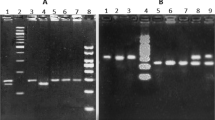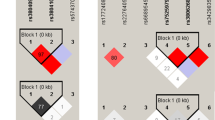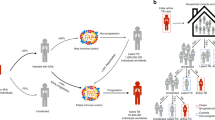Abstract
We have determined IL-10 promoter genotypes of five single-nucleotide polymorphisms (SNPs): T−3575A, A−2849G, C−2763A, -A−1082G and C−819T. The haplotype frequencies were defined in healthy subjects compared to leprosy patients, and analyzed for their occurrence in multi- (MB) vs paucibacillary (PB) as severe and mild forms of leprosy, respectively. Haplotypes defined by three SNP positions (−3575, −2849 and −2763) captured significant differences between controls and patients (P=0.04). The haplotype carrying −3575A, −2849G and −2763C was associated with resistance to leprosy and to the development of severe forms of the disease using either a binomial (controls vs cases, P=0.005, OR=0.35, CI=0.13–0.91) or ordinal (controls vs PB vs MB, P=0.006, OR=0.32, CI=0.12–0.83) model. By contrast, the IL-10 haplotype −3575T/−2849A/−2763C was found to be associated with susceptibility to leprosy per se (P=0.027, OR=2.37, CI=1.04–5.39), but not leprosy type. The data suggest that the IL-10 locus contributes to the outcome of leprosy.
This is a preview of subscription content, access via your institution
Access options
Subscribe to this journal
Receive 6 digital issues and online access to articles
$119.00 per year
only $19.83 per issue
Buy this article
- Purchase on Springer Link
- Instant access to full article PDF
Prices may be subject to local taxes which are calculated during checkout
Similar content being viewed by others
References
Fine PE, Sterne JA, Ponnighaus JM et al. Household and dwelling contact as risk factors for leprosy in northern Malawi. Am J Epidemiol 1997; 146: 91–102.
Feitosa M, Krieger H, Borecki I, Beiguelman B, Rao DC . Genetic epidemiology of the Mitsuda reaction in leprosy. Hum Hered 1996; 46: 32–35.
Ottenhoff THM, Verreck FAW, Lichtenauer-Kaligis EGR, Hoeve MA, Sanal O, Van Dissel JT . Genetics, cytokines and human infectious disease: lessons from weakly pathogenic mycobacteria and salmonellae. Nat Genet 2002; 32: 97–105.
Fitness J, Tosh K, Hill AV . Genetics of susceptibility to leprosy. Genes Immun 2002; 3: 441–453.
Mira MT, Alcais A, Van Thuc N et al. Chromosome 6q25 is linked to susceptibility to leprosy in a Vietnamese population. Nat Genet 2003; 33: 412–415.
Mira MT, Alcaïs A, Thuc NV et al. A 5-prime regulatory region shared by the PARK2 and PACRG genes controls susceptibility to leprosy. Nature 2004; 427: 636–640.
Jamieson SE, Miller EN, Black GF et al. Evidence for a cluster of genes on chromosome 17q11–q21 controlling susceptibility to tuberculosis and leprosy in Brazilians. Genes Immun 2004; 5: 46–57.
Ottenhoff TH, Spierings E, Nibbering PH, de Jong R . Modulation of protective and pathological immunity in mycobacterial infections. Int Arch Allergy Immunol 1997; 113: 400–408.
Lima MC, Pereira GM, Rumjanek FD et al. Immunological cytokine correlates of protective immunity and pathogenesis in leprosy. Scand J Immunol 2000; 51: 419–428.
Misra N, Murtaza A, Walker B et al. Cytokine profile of circulating T cells of leprosy patients reflects both indiscriminate and polarized T-helper subsets: T-helper phenotype is stable and uninfluenced by related antigens of Mycobacterium leprae. Immunology 1995; 86: 97–103.
Eskdale J, Keijsers V, Huizinga T, Gallagher G . Microsatellite alleles and single nucleotide polymorphism (SNP) combine to form four major haplotype families at the human inteleukin-10 (IL-10) locus. Genes and Immun 1999; 1: 151–155.
Gibson AW, Edberg JC, Wu J, Westerdorp RG, Huizinga TWJ, Kimberly RP . Novel single nucleotide polymorphisms in the distal IL-10 promoter affect IL-10 production and enhance the risk of systemic lupus erythematosus. J Immunol 2001; 166: 3915–3922.
Turner DM, Williams DM, Sankaran D, Lazarus M, Sinnott PJ, Hutchinson IV . An investigation of polymorphism in the interleukin-10 gene promoter. Eur J Immunogenet 1997; 24: 1–8.
Koss K, Satsangi J, Fanning GC, Welsh KI, Jewell DP . Cytokine (TNF alpha, LT alpha and IL-10) polymorphisms in inflammatory bowel diseases and normal controls: differential effects on production and allele frequencies. Genes Immun 2000; 1: 185–190.
Ridley DS, Jopling WH . Classification of leprosy according to immunity—a five group system. Int J Lepr 1966; 34: 255–273.
Santos AR, Suffys PN, Vanderborght PR et al. Role of tumor necrosis factor-alpha and interleukin-10 promoter gene polymorphisms in leprosy. J Infect Dis 2002; 186: 1687–1691.
Moraes MO, Santos AR, Schonkeren JJ et al. Interleukin-10 promoter haplotypes are differently distributed in the Brazilian versus the Dutch population. Immunogenetics 2003; 54: 896–899.
Schaid DJ, Rowland CM, Tines DE, Jacobson RM, Poland GA . Score tests for association between traits and haplotypes when linkage phase is ambiguous. Am J Hum Genet 2002; 70: 425–434.
Terwilliger JD, Ott J (Eds) Linkage disequilibrium between alleles at marker loci. In: Handbook of Human Genetics Linkage. The John Hopkins University Press: Baltimore and London, 1994, pp 188–193.
Ihaka R, Gentleman R . A language for data analysis and graphics. J Comput Graph Stat 1996; 5: 299–314.
Miller EN, Jamieson SE, Joberty C et al. Genome-wide scans for leprosy and tuberculosis susceptibility genes in Brazilians. Genes Immun 2004; 5: 63–67.
Editorial Freely associating. Nat Genet 1999; 22: 1–2.
Acknowledgements
We are grateful to Valcemir F Silva-Filho for technical assistance and Denise Vieira for sample collection. These studies were supported in part by the World Health Organization/World Bank/TDR, the Netherlands Leprosy Foundation (NLR) and the Royal Netherlands Academy of Arts and Sciences (KNAW).
Author information
Authors and Affiliations
Corresponding author
Rights and permissions
About this article
Cite this article
Moraes, M., Pacheco, A., Schonkeren, J. et al. Interleukin-10 promoter single-nucleotide polymorphisms as markers for disease susceptibility and disease severity in leprosy. Genes Immun 5, 592–595 (2004). https://doi.org/10.1038/sj.gene.6364122
Received:
Revised:
Accepted:
Published:
Issue Date:
DOI: https://doi.org/10.1038/sj.gene.6364122
Keywords
This article is cited by
-
ACAT-1 gene rs1044925 SNP and its relation with different clinical forms of chronic Chagas disease
Parasitology Research (2019)
-
A large-scale genome-wide association and meta-analysis identified four novel susceptibility loci for leprosy
Nature Communications (2016)
-
Longitudinal immune profiles in type 1 leprosy reactions in Bangladesh, Brazil, Ethiopia and Nepal
BMC Infectious Diseases (2015)
-
Increased interleukin-10 and interferon-γ levels in Plasmodium vivax malaria suggest a reciprocal regulation which is not altered by IL-10 gene promoter polymorphism
Malaria Journal (2011)
-
IFNG +874 T>A single nucleotide polymorphism is associated with leprosy among Brazilians
Human Genetics (2010)



